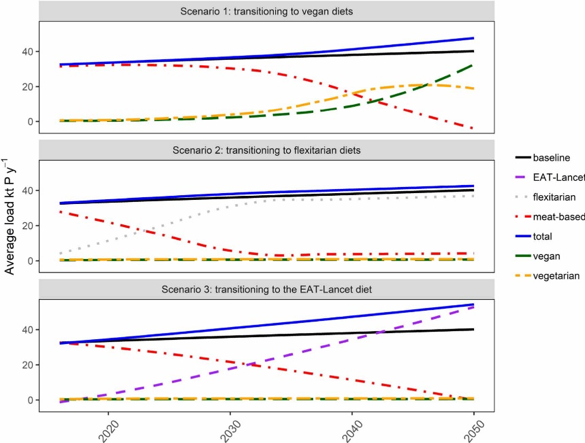 Contact
Contact
 Helen Jarvie, Department of Geography and Environmental Management
Helen Jarvie, Department of Geography and Environmental Management
Introduction
Agriculture is one of the largest drivers of nutrient use and water-quality impairment. There is growing interest in plant-based diets to improve nutrition, while helping to reduce greenhouse gas (GHG) emissions and moderate the indirect impacts on the environment. Phosphorus (P) is an essential nutrient that supports global agricultural production, but inefficiencies in its use are causing costly, long-term eutrophication and water-quality degradation.
While transitioning towards a plant-based diet seems beneficial for P sustainability by reducing global P fertilizer demand and the potential for nonpoint-source pollution, this may result in increasing the P burden entering wastewater treatment plants (WWTP) and subsequent P effluent discharge to receiving water bodies. In this paper, we examined trends in dietary P consumption in the United Kingdom (UK) and how selected scenarios of potential dietary change might impact the P burden onto WWTP and effluent discharges to receiving waters.
Methodology
We estimated average dietary P consumption per person in the UK between 1942 and 2016 based on the per capita consumption of different food types and their P content. To calculate the dietary P burden entering WWTP, the per capita dietary P consumption was multiplied by the UK population for the respective year.
Three dietary change scenarios were analyzed to assess how such a change might impact the P burden to WWTP and effluent discharges between 2016 to 2050 compared to a baseline scenario of no change (Table 1). First, per capita annual P consumption rates were combined with the projected increases in population to estimate the total dietary P load entering WWTP. Second, discharges of P in wastewater effluent to receiving waters for each dietary scenario were calculated to estimate the amount of total P load that will require removal. Finally, we examined a subset of different-sized WWTP to estimate the effluent discharge of P to water and determine the dietary effect, in relation to regulatory P compliance targets.
|
Scenario |
Description |
|
Baseline |
Assumes no change in current dietary consumption patterns of the population: 2.09 per cent vegetarians, 1.16 per cent vegans, and 96.75 per cent eating the current meat-based diet. |
|
Scenario 1: transitioning to vegan diets |
Assumes a predominantly vegan population in 2050. Initially the current ratio of vegan and vegetarians (1.16 : 2.09) does not change and the percentage of the population that is vegan or vegetarian increases 13 per cent annually. The remaining percentage of the population consumes a meat-based diet until 2045 whereby none of the population consumes meat. From 2045 onwards vegetarian diets decline at a rate of 13 per cent a year, whilst veganism continues to increase to constitute 70 per cent of the population in 2050. |
|
Scenario 2: transitioning to flexitarian diets |
Assumes that 21 per cent of the population is currently flexitarian, the current percentages of vegan (1.16 per cent) and vegetarians (2.09 per cent) does not change, and meat-based diets decline as flexitarian diets increase by 13 per cent annually until 2030 whereby meat-based diets remain stable at 10 per cent of the population. |
|
Scenario 3: transitioning to the EAT-lancet diet |
Assumes meat-eaters transition to the EAT-Lancet diet by 2050 (3 per cent increase per year in per cent of population which has EAT-Lancet diet) and the current population percentage of vegetarians (2.09 per cent) and vegans (1.16 per cent) remains the same. |
Table 1. Dietary change scenarios
Outcomes
The study found that the total dietary wastewater P burden has increased since 1942, due to increasing population as opposed to average P consumption per person. During this period, the contribution of processed foods to total P consumption increased from 21 per cent to 52 per cent, but consumption of total animal products did not change significantly. Although the study did not identify any significant increase in the proportional P burden related to the consumption of animal products since 1942, animal products still contribute 50 per cent of the wastewater P burden in the UK.
Results show that while population growth has driven historical increases in UK wastewater P burdens, proposed changes towards more environmentally sustainable plant-based diets in the future could cause substantial increases in the dietary P burden (Figure 1). For a predominantly vegan or EAT-Lancet diet, the P burden would increase by 17 per cent and 35 per cent respectively by 2050, compared to the baseline scenario. A much lower P burden increase (6 per cent) was obtained with a flexitarian diet.

Figure 1: Average phosphorus (P) load to wastewater treatment works from the three dietary change scenarios and the no change baseline scenario.
Effluent discharges from WWTPs to receiving waters are estimated to increase by 24 per cent in 2050 under the baseline scenario (Figure 2). The analyses suggest that discharges of P to receiving waters could increase by 44 per cent and 64 per cent in Scenario 1 and 3, respectively, while a 31 per cent increase is likely for Scenario 2. When considering the subset of WWTP examined and P-removal compliance targets, the study found that all scenarios would result in an increase in non-compliance by 2050 (between 57-73 per cent of the subset of WWTP analysed).

Figure 2: Phosphorus (P) discharges from wastewater treatment plants and septic tanks to receiving waters under the three dietary change and no change baseline scenarios.
Conclusions
The study results show that while population growth was the main driver of increases in wastewater P burdens in the UK between 1942 and 2016, changes towards healthier and more sustainable plant-based diets could ironically cause substantial increases in the dietary P burden on WWTP and increases in point-source P discharges to receiving waters. While the results are not meant to diminish the overall value of shifting to healthier, sustainable diets, they highlight the increasing importance of the wastewater industries in the drive towards P sustainability and the potential for enhanced P recovery from wastewater for the provision of renewable fertilizers.
WWTP will require significant investments and the introduction of new technologies to improve P removal efficiencies to meet increasingly stringent compliance targets for effluent P discharges. Reducing excess food intake and wastage, and consuming fresh food, less meat and less processed food would help to minimize both the pre-consumption demand for P and the post-consumption P burden on the wastewater industry.
Forber, K.J., Rothwell, S.A., Metson, G.S., Jarvie, H.P. & Withers, P.J.A. (2020). Plant-based diets add to the wastewater phosphorus burden. Environmental Research Letters, 15(9), 094018. doi: 10.1088/1748-9326/ab9271
For more information about WaterResearch, contact Allie Dusome.







